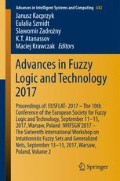Abstract
Edge detection comprises different stages that go from adaptation of the original image -conditioning- to the selection of the definitive edges. This last step, known as scaling, requires the application of a thresholding process over the gradients of luminosity values of the pixels. Traditionally, this is made through a local evaluation process that works pixel by pixel. As the edge candidate pixels are not independent, a wider strategy suggests the use of a more global evaluation. In this sense, this approach resembles more the human vision. This paper further develops ideas related to edge lists, first proposed in 1995 [1]. This paper will refer to edge lists as edge segments. These segments contain visual features similar to the ones that humans use, which might lead to better comparative results. In this paper we propose using clustering techniques to differentiate the appropriate segments or true segments from the false ones, and we introduce an algorithm that uses fuzzy clustering techniques. Finally, this paper shows that this fuzzy clustering over the segments performs at least as well as other standard algorithms used for edge detection.
Access this chapter
Tax calculation will be finalised at checkout
Purchases are for personal use only
References
Venkatesh, S., Rosin, P.L.: Dynamic threshold determination by local and global edge evaluation. Graph. Models Image Process. 57(2), 146–160 (1995)
Marr, D., Hildreth, E.: Theory of edge detection. Proc. Roy. Soc. London - Biol. Sci. 207(1167), 187–217 (1980)
Marr, D.: Vision: A Computational Investigation into the Human Representation and Processing of Visual Information. The MIT Press, Cambridge (1982)
Goldstein, E.B.: Sensación y percepción, Sexta edn. Thomson Editores, Spain (2009)
Sobel,I.: History and definition of the Sobel Operator (2014)
Canny, J.: A computational approach to edge detection. IEEE Trans. Pattern Anal. Mach. Intell., PAMI 8(6), 679–698 (1986)
López-Molina, C.: The breakdown structure of edge detection-analysis of individual components and revisit of the overall structure. Ph.D. thesis, Universidad Pública de Navarra (2012)
McAndrew, A.: An Introduction of Image Processing with Matlab. Course Technology Press, Boston (2004)
del Amo, A., Gómez, D., Montero, J., Biging, G.: Relevance and redundancy in fuzzy classification systems. Mathware Soft Comput. 8, 203–216 (2001)
Martin, D., Fowlkes, C., Tal, D., Malik, J.: A database of human segmented natural images and its application to evaluating segmentation algorithms and measuring ecological statistics. In: Proceedings of the IEEE International Conference on Computer Vision, vol. 2, pp. 416–423 (2001)
Estrada, F.J., Jepson, A.D.: Benchmarking image segmentation algorithms. Int. J. Comput. Vis. 85–2, 167–181 (2009)
Guada, C., Gómez, D., Rodríguez, J.T., Yánez, J., Montero, J.: Classifying images analysis techniques from their output. Int. J. Comput. Intell. Syst. 9(1), 43–68 (2016)
Basu, M.: Gaussian-based edge-detection methods- a survey. IEEE Trans. Syst. Man Cybern. Part C: Appl. Rev. 32(3), 252–260 (2002)
Morillas, S., Gregori, V., Hervas, A.: Fuzzy peer groups for reducing mixed Gaussianimpulse noise from color images. IEEE Trans. Image Process. 18(7), 1452–1466 (2009)
Bezdek, J., Chandrasekhar, R., Attikouzel, Y.: A geometric approach to edge detection. IEEE Trans. Fuzzy Syst. 6(1), 52–75 (1998)
Bustince, H., Barrenechea, E., Pagola, M., Fernandez, J.: Interval-valued fuzzy sets constructed from matrices: application to edge detection. Fuzzy Sets Syst. 160(13), 1819–1840 (2009)
Kim, D.S., Lee, W.H., Kweon, I.S.: Automatic edge detection using \(3\times 3\) ideal binary pixel patterns and fuzzy-based edge thresholding. Pattern Recogn. Lett. 25(1), 101–106 (2004)
Russo, F.: FIRE operators for image processing. Fuzzy Sets Syst. 103(2), 265–275 (1999)
Russo, F., Ramponi, G.: Edge extraction by FIRE operators. In: Proceedings of the IEEE Conference on Fuzzy Systems, vol. 1, pp. 249–253 (1994)
Monga, O., Deriche, R., Malandain, G., Cocquerez, J.P.: Recursive filtering and edge tracking: two primary tools for 3D edge detection. Image Vis. Comput. 9(4), 203–214 (1991)
Fathy, M., Siyal, M.Y.: An image detection technique based on morphological edge detection and background differencing for real-time traffic analysis. Pattern Recogn. Lett. 16(12), 1321–1330 (1995)
Zielke, T., Brauckmann, M., Vonseelen, W.: Intensity and edge-based symmetry detection with an application to car-following. CVGIP: Image Underst. 58(2), 177–190 (1993)
Pal, S., King, R.: On edge detection of X-ray images using fuzzy sets. IEEE Trans. Pattern Anal. Mach. Intell. 5(1), 69–77 (1983)
Sonka, M.: IEEE transactions on medical imaging statement of editorial policy. IEEE Trans. Med. Imaging 33(4) (2014)
Rojas, K., Gómez, D., Montero, J., Rodríguez, J.T., Valdivia, A., Paiva, F.: Development of child’s home environment indexes based on consistent families of aggregation operators with prioritized hierarchical information. Fuzzy sets Syst. 241, 41–60 (2014). Elsevier
Acknowledgement
It has been strongly helpfull for the conducting of this research the code of KERMIT Research Unit (Ghent University), The Kermit Image Toolkit (KITT), B. De Baets, C. Lopez-Molina (Eds.), Available online at www.kermitimagetoolkit.net.
Author information
Authors and Affiliations
Corresponding author
Editor information
Editors and Affiliations
Rights and permissions
Copyright information
© 2018 Springer International Publishing AG
About this paper
Cite this paper
Flores-Vidal, P.A., Gómez, D., Olaso, P., Guada, C. (2018). A New Edge Detection Approach Based on Fuzzy Segments Clustering. In: Kacprzyk, J., Szmidt, E., Zadrożny, S., Atanassov, K., Krawczak, M. (eds) Advances in Fuzzy Logic and Technology 2017. EUSFLAT IWIFSGN 2017 2017. Advances in Intelligent Systems and Computing, vol 642. Springer, Cham. https://doi.org/10.1007/978-3-319-66824-6_6
Download citation
DOI: https://doi.org/10.1007/978-3-319-66824-6_6
Published:
Publisher Name: Springer, Cham
Print ISBN: 978-3-319-66823-9
Online ISBN: 978-3-319-66824-6
eBook Packages: EngineeringEngineering (R0)

